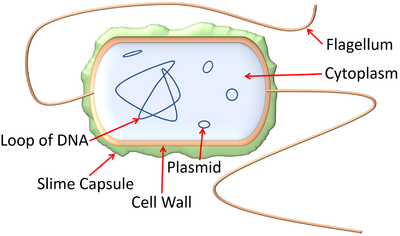Difference between revisions of "Prokaryotic Cell"
| Line 8: | Line 8: | ||
: '''Prokaryotic cells''' have no [[Cell Nucleus|nucleus]], [[mitochondria]] or [[chloroplast]]s. | : '''Prokaryotic cells''' have no [[Cell Nucleus|nucleus]], [[mitochondria]] or [[chloroplast]]s. | ||
: '''Prokaryotic cells''' are usually much smaller than [[Eukaryotic Cell|eukaryotic cells]]. | : '''Prokaryotic cells''' are usually much smaller than [[Eukaryotic Cell|eukaryotic cells]]. | ||
| + | |||
| + | ===Examples=== | ||
| + | {| class="wikitable" | ||
| + | |- | ||
| + | |[[File:BacteriaDiagram2.png|center|400px]] | ||
| + | |- | ||
| + | | style="height:20px; width:200px; text-align:center;" |A [[diagram]] showing a [[bacteria|bacterium]] which is a '''prokaryote'''. | ||
| + | |} | ||
Revision as of 20:34, 4 June 2019
Key Stage 4
Meaning
A prokaryotic cell is a simple cell which contains no membrane bound organelles.
About Prokaryotic Cells
- Prokaryotic cells include bacteria and some types of algae.
- Prokaryotic cells have a loop of DNA floating freely in the cytoplasm.
- Prokaryotic cells have no nucleus, mitochondria or chloroplasts.
- Prokaryotic cells are usually much smaller than eukaryotic cells.
Examples
| A diagram showing a bacterium which is a prokaryote. |
